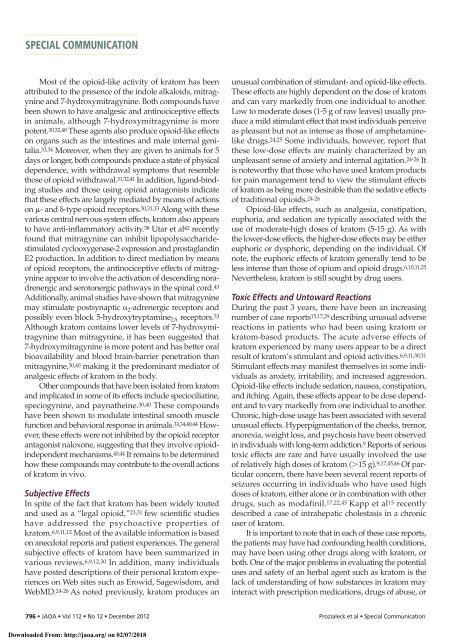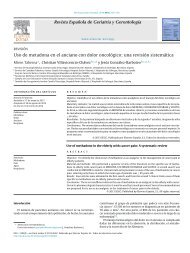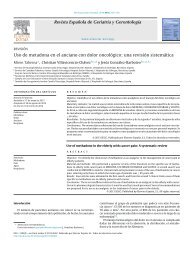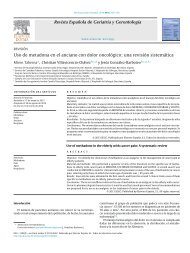Kratom
You also want an ePaper? Increase the reach of your titles
YUMPU automatically turns print PDFs into web optimized ePapers that Google loves.
SPECIAL COMMUNICATION<br />
Most of the opioid-like activity of kratom has been<br />
attributed to the presence of the indole alkaloids, mitragynine<br />
and 7-hydroxymitragynine. Both compounds have<br />
been shown to have analgesic and antinociceptive effects<br />
in animals, although 7-hydroxymitragynime is more<br />
potent. 30,32,40 These agents also produce opioid-like effects<br />
on organs such as the intestines and male internal genitalia.<br />
33,34 Moreover, when they are given to animals for 5<br />
days or longer, both compounds produce a state of physical<br />
dependence, with withdrawal symptoms that resemble<br />
those of opioid withdrawal. 31,32,41 In addition, ligand-binding<br />
studies and those using opioid antagonists indicate<br />
that these effects are largely mediated by means of actions<br />
on μ- and δ-type opioid receptors. 30,31,33 Along with these<br />
various central nervous system effects, kratom also appears<br />
to have anti-inflammatory activity. 38 Utar et al 42 recently<br />
found that mitragynine can inhibit lipopolysaccharidestimulated<br />
cyclooxygenase-2 expression and prostaglandin<br />
E2 production. In addition to direct mediation by means<br />
of opioid receptors, the antinociceptive effects of mitragynine<br />
appear to involve the activation of descending noradrenergic<br />
and serotonergic pathways in the spinal cord. 43<br />
Additionally, animal studies have shown that mitragynine<br />
may stimulate postsynaptic α 2 -adrenergic receptors and<br />
possibly even block 5-hydroxytryptamine 2A receptors. 33<br />
Although kratom contains lower levels of 7-hydroxymitragynine<br />
than mitragynine, it has been suggested that<br />
7-hydroxymitragynine is more potent and has better oral<br />
bioavailability and blood brain-barrier penetration than<br />
mitragynine, 30,40 making it the predominant mediator of<br />
analgesic effects of kratom in the body.<br />
Other compounds that have been isolated from kratom<br />
and implicated in some of its effects include speciociliatine,<br />
speciogynine, and paynatheine. 30,40 These compounds<br />
have been shown to modulate intestinal smooth muscle<br />
function and behavioral response in animals. 33,34,40,44 However,<br />
these effects were not inhibited by the opioid receptor<br />
antagonist naloxone, suggesting that they involve opioidindependent<br />
mechanisms. 40,44 It remains to be determined<br />
how these compounds may contribute to the overall actions<br />
of kratom in vivo.<br />
Subjective Effects<br />
In spite of the fact that kratom has been widely touted<br />
and used as a “legal opioid,” 23,31 few scientific studies<br />
have addressed the psychoactive properties of<br />
kratom. 6,9,11,12 Most of the available information is based<br />
on anecdotal reports and patient experiences. The general<br />
subjective effects of kratom have been summarized in<br />
various reviews. 6,9,12,30 In addition, many individuals<br />
have posted descriptions of their personal kratom experiences<br />
on Web sites such as Erowid, Sagewisdom, and<br />
WebMD. 24-26 As noted previously, kratom produces an<br />
unusual combination of stimulant- and opioid-like effects.<br />
These effects are highly dependent on the dose of kratom<br />
and can vary markedly from one individual to another.<br />
Low to moderate doses (1-5 g of raw leaves) usually produce<br />
a mild stimulant effect that most individuals perceive<br />
as pleasant but not as intense as those of amphetaminelike<br />
drugs. 24,25 Some individuals, however, report that<br />
these low-dose effects are mainly characterized by an<br />
unpleasant sense of anxiety and internal agitation. 24-26 It<br />
is noteworthy that those who have used kratom products<br />
for pain management tend to view the stimulant effects<br />
of kratom as being more desirable than the sedative effects<br />
of traditional opioids. 24-26<br />
Opioid-like effects, such as analgesia, constipation,<br />
euphoria, and sedation are typically associated with the<br />
use of moderate-high doses of kratom (5-15 g). As with<br />
the lower-dose effects, the higher-dose effects may be either<br />
euphoric or dysphoric, depending on the individual. Of<br />
note, the euphoric effects of kratom generally tend to be<br />
less intense than those of opium and opioid drugs. 6,10,11,25<br />
Nevertheless, kratom is still sought by drug users.<br />
Toxic Effects and Untoward Reactions<br />
During the past 3 years, there have been an increasing<br />
number of case reports 15,17,29 describing unusual adverse<br />
reactions in patients who had been using kratom or<br />
kratom-based products. The acute adverse effects of<br />
kratom experienced by many users appear to be a direct<br />
result of kratom’s stimulant and opioid activities. 6,9,11,30,31<br />
Stimulant effects may manifest themselves in some individuals<br />
as anxiety, irritability, and increased aggression.<br />
Opioid-like effects include sedation, nausea, constipation,<br />
and itching. Again, these effects appear to be dose dependent<br />
and to vary markedly from one individual to another.<br />
Chronic, high-dose usage has been associated with several<br />
unusual effects. Hyperpigmentation of the cheeks, tremor,<br />
anorexia, weight loss, and psychosis have been observed<br />
in individuals with long-term addiction. 9 Reports of serious<br />
toxic effects are rare and have usually involved the use<br />
of relatively high doses of kratom (>15 g). 9,17,45,46 Of particular<br />
concern, there have been several recent reports of<br />
seizures occurring in individuals who have used high<br />
doses of kratom, either alone or in combination with other<br />
drugs, such as modafinil. 17,22,45 Kapp et al 15 recently<br />
described a case of intrahepatic cholestasis in a chronic<br />
user of kratom.<br />
It is important to note that in each of these case reports,<br />
the patients may have had confounding health conditions,<br />
may have been using other drugs along with kratom, or<br />
both. One of the major problems in evaluating the potential<br />
uses and safety of an herbal agent such as kratom is the<br />
lack of understanding of how substances in kratom may<br />
interact with prescription medications, drugs of abuse, or<br />
796 • JAOA • Vol 112 • No 12 • December 2012 Prozialeck et al • Special Communication<br />
Downloaded From: http://jaoa.org/ on 02/07/2018







